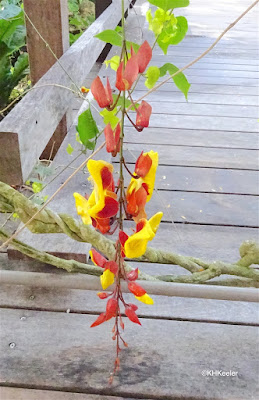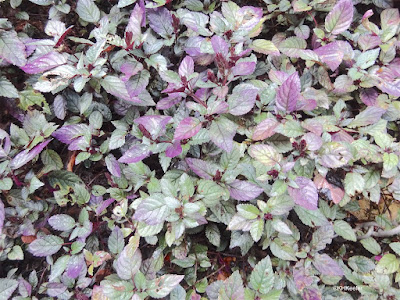It was February and South Florida was green, while the northern half of North America was white (or brown).
South Florida was also yellow, red and purple...
and that was just the leaves
I took a tour with the Minnesota Landscape Arboretum, from Naples and Fort Myers on the Gulf (west) Coast to Miami, Delray Beach, and Key Largo on the Atlantic. Coming from days where the high was 40 with humidity under 40%, it was quite a change to have 80 degree temperatures and 75% humidity.
South Florida has the occasional frost, perhaps a serious one every 20 years. In between, they grow many tropical plants and, with abundant rain (60" a year) and warm temperatures, those plants can--
and do--grow very large. We cold-climate people reveled in sunshine, leaves and flowers, bees and butterflies, in February.
 |
| beautiful bougainvillea (Bougainvillea sp., four o'clock family, Nyctaginaceae) |
 |
| Clock vine flower, Thunbergia mysorensis, Asian vine (acanthus family, Acanthaceae) |
 |
| sky vine, Thunbergia grandiflora, from India (acanthus family, Acanthaceae) |
I did notice some things other than plants.
A lizard:
The water. This is Sundowners Restaurant on Key Largo, looking into the Gulf.
| And this: |
 |
| concrete with seashells |
This is a section of pavement in Naples. Those little white things are sea shells that were added to the concrete. It still bothers me. For me, a single sea shell is a rare prize, something I put in my pocket and take home to display on the knickknack shelf. Here, they mixed them into the concrete to be inevitably beaten to powder by the feet of pedestrians. I try to see it from a Florida point-of-view but I can't help reacting to it as Such Extravagance!
And then there were more flowers
 |
| moth orchid (Phalaenopsis) from southeast Asia or Australia (orchid family, Orchidaceae) |
 |
| an epi orchid (Epidendrum) growing on the ground (orchid family, Orchidaceae) |
 |
| a euphorbia with two honey bees, (There are 2,000 species in Euphorbia; I can't identify this one. In th spurge and poinsettia family, Euphorbiaceae) |
 |
| starburst bush, Clerodendrum quadriloculare from New Guinea (mint family, Lamiaceae) |
 |
| Banyan tree, Edison and Ford Winter Estate, Fort Myers, Florida |
 |
| baobab, Adansonia digitata |
These are images of a few of the spectacular tropical plants introduced to south Florida. I'll talk about native habitats in future blogs.
 |
| a mallow looking like a Japanese painting |
References
Glasener, E. 2018. The magic of banyan trees link Accessed 2/28/20.
Kathy Keeler, A Wandering Botanist
More at awanderingbotanist.com







No comments:
Post a Comment